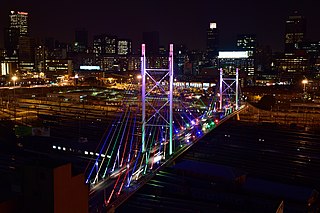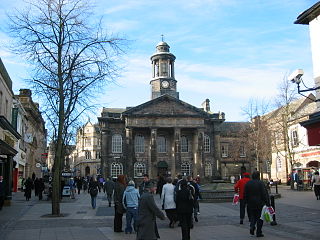
Johannesburg is the most populous city in South Africa with 4,803,262 people, and is classified as a megacity; it is one of the 100 largest urban areas in the world. It is the provincial capital of Gauteng, the wealthiest province in South Africa. Johannesburg is the seat of the Constitutional Court, the highest court in South Africa. Most of the major South African companies and banks have their head offices in Johannesburg. The city is located within the mineral-rich Witwatersrand hills, the epicentre of the international-scale mineral, gold and (specifically) diamond trade.

Sandton is a financial, commercial and residential area, located in the northern part of the City of Johannesburg Metropolitan Municipality. Formerly an independent municipality, Sandton's name came from the combination of two of its suburbs, Sandown and Bryanston.

Midrand is a town in central Gauteng, South Africa. It is situated in-between Centurion and Sandton. Formerly an independent municipality, Midrand now forms part of the City of Johannesburg Metropolitan Municipality.

Johannesburg is a large city in Gauteng Province of South Africa. It was established as a small village controlled by a Health Committee in 1886 with the discovery of an outcrop of a gold reef on the farm Langlaagte. The population of the city grew rapidly, becoming a municipality in 1898. In 1928 it became a city making Johannesburg the largest city in South Africa. In 2002 it joined ten other municipalities to form the City of Johannesburg Metropolitan Municipality. Today, it is a centre for learning and entertainment for all of South Africa. It is also the capital city of Gauteng.
City Deep is an industrial suburb of Johannesburg, South Africa. It is located in Region F of the City of Johannesburg Metropolitan Municipality. Locally is a large container terminal of Transnet Freight Rail in operation, the most significant dry port of the country, and the Joburg Market.

The City of Johannesburg Metropolitan Municipality is a metropolitan municipality that manages the local governance of Johannesburg, the largest city in South Africa. It is divided into several branches and departments in order to expedite services for the city. Zulu is the most spoken home language at 23.4% followed by English at 20.1%.

The Narainsamy Temple is a provincial heritage site in Inanda in the KwaZulu-Natal province of South Africa. It was founded by Narainsamy in 1896, and is now controlled by a family trust that he created. Most of the congregation are Tamil Hindus.

Johannesburg Park Station is the central railway station in the city of Johannesburg, South Africa, and the largest railway station in Africa. It is located between the Central Business District and Braamfontein, in the block bordered by Rissik, Wolmarans, Wanderers, and Noord Streets. Park Station lies on the main Witwatersrand railway line that runs East-West from Krugersdorp to Germiston. The first four stations to the east are Doornfontein, Ellis Park, Jeppe and George Goch Stations.

Johannesburg is the capital of the Gauteng province and the financial hub of South Africa. Founded in 1886, the city is located in the Witwatersrand region, which has vast gold deposits. The town experienced rapid growth as the gold deposits were exploited, and is now South Africa's largest urban centre. As a result, the Johannesburg area has a wide variety of architecture, from early Art Nouveau to Postmodern buildings. Hillbrow, for example, contains many buildings constructed since the 1950s, including the Hillbrow Tower.

Lancaster City Museum is a museum in Lancaster, Lancashire, England. It is housed in the former Lancaster Town Hall building in Market Square.

The Market Hall, in Priory Street, Monmouth, Wales, is an early Victorian building by the prolific Monmouth architect George Vaughan Maddox. It was constructed in the years 1837–39 as the centrepiece of a redevelopment of part of Monmouth town centre. After being severely damaged by fire in 1963, it was partly rebuilt and was the home of Monmouth Museum from 1969 to 2021. At the rear of the building are original slaughterhouses, called The Shambles, opening onto the River Monnow. The building is Grade II listed as at 27 June 1952, and it is one of 24 buildings on the Monmouth Heritage Trail. The Shambles slaughterhouses are separately listed as Grade II*.

The National Bank Building also known as the Corner House is situated on the corner of Market and Simmonds Streets in Johannesburg. The address 38-40 Simmonds Street corresponds to Stand 205 F.

Johannesburg City Hall is an Edwardian building constructed in 1914 by the Hawkey and McKinley construction company. The plan for the building was drawn in 1910 and construction was started in 1913 and finished in 1914. The Gauteng Provincial Legislature currently occupies the building. The City Hall has seen many political events on its steps from protest meetings to a bomb blast in 1988.

The Rand Water Board was established in 1903, tasked with supplying the water needed to support mining activities and sanitary living conditions for those living in the developing urban area of Johannesburg.

The Berea Fire station was constructed to serve the northern district of Johannesburg in 1910. It is situated in stand 927/8 on Mitchell Street in Berea. It is sometimes known as the Doll's House and it is the oldest functioning fire station in Johannesburg. The station was built in a time when Johannesburg had electricity but paraffin lamps were still providing lighting, which added to serious fire threats.

Dr. Xuma's house was one of two houses to escape the destruction of Sophiatown, South Africa by the government in the late 1950s, it is also a landmark which belonged to Dr Alfred Bitini Xuma who was a medical doctor and the President of the African National Congress (ANC) and Chairperson of the Western Areas Anti-Expropriation and Proper Housing Committee. Construction of the house was completed in 1935 and named Empilweni which roughly translates to "the place of life". Xuma and his second wife Madie Hall Xuma lived there until his own property was expropriated when Sophiatown was declared a White area in terms of the Native Resettlement Act of 1954, and he had vacated it by 1957.

Queensland National Bank is a heritage-listed former bank building at Jessie Street, Irvinebank, Shire of Mareeba, Queensland, Australia. It was built c. 1905. It was added to the Queensland Heritage Register on 21 October 1992.

Corn exchanges are distinct buildings which were originally created as a venue for corn merchants to meet and arrange pricing with farmers for the sale of wheat, barley, and other corn crops. The word "corn" in British English denotes all cereal grains, such as wheat and barley. With the repeal of the Corn Laws in 1846, a large number of corn exchanges were built in England, particularly in the corn-growing areas of Eastern England.

International House is a heritage-listed commercial building at 14-16 York Street, in the Sydney central business district, in the City of Sydney local government area of New South Wales, Australia. It was designed by Robertson & Marks and built during 1913 by Howie, Brown & Moffat, Master Builders. It is also known as Pomeroy House. It was added to the New South Wales State Heritage Register on 2 April 1999.



















